Line Cord Resistors and
other Heater Droppers.
This page has come about mainly as a result
of having open circuit line cord resistors in eight out of my nine Meck
FM converters. This series of articles examines the options for modern
substitutes and other schemes for dropping the mains voltage for where
a series heater power supply is used. Where a transformerless power supply
is used for a radio or television set, the most efficient method of powering
the valve heaters is to connect them all in series, since the current through
the dropping device is a fraction of what it would be if the heaters were
in parallel. To this end, valves were designed specifically for this type
of operation. They have a controlled warm up time, so that individual valve
heaters are not overloaded during warm up, and the heaters are designed
for a specific current rather than voltage. European design favoured 100mA
and 200mA heater valves for radios, and 300mA for television. In the U.S.,
radios initially used a 300mA heater string, then 150mA. In most instances,
the 150mA valve voltages added up to around 120V, thus eliminating the
need for a dropper resistor. U.S. televisions initially used a 600mA heater
string, which was sometimes divided into two 300mA strings for part of
the circuit. 450mA was standardised later on.
In the early days, the series heater arrangement
came about to permit operation from DC mains, since transformer type power
supplies are suitable for AC only. However, the scheme remained in use
even when DC mains were no more. The main reason was that it eliminated
the heavy, bulky, and expensive power transformer. This convenience comes
at a disadvantage, with the internal circuitry, and usually also the chassis,
connected to one side of the mains, making it a shock hazard. Some apparatus
was better than others, in regard to avoiding a shock hazard to the user.
Methods for voltage dropping.
Where the sum of valve heater voltages
adds up to less than the mains voltage, the difference has to be dropped
by some means. Methods to do this include resistors, barretters, light
bulbs, or when the supply is AC only, capacitors, diodes, or transformers.
Resistive devices are cheap and popular, as well as functioning on both
AC or DC mains. They can be in the form of an ordinary wirewound resistor,
a barretter, light bulb, ballast tube, or a line cord resistor. The disadvantage
is that all the voltage dropped is converted to heat. 30W is not atypical
of the sort of dissipation. The overall power consumption is also higher
than if a power transformer was/could be used. When the mains is AC only,
other more efficient methods can be used. One well known method is to use
the reactance of a capacitor. The advantage here is no heat dissipated.
Another method, very popular in UK made television sets, is to use a silicon
diode, presenting a half wave current to the valve heaters. By using a
diode this way, the dissipation in the heater dropper resistor is reduced,
because the diode only conducts on every half cycle of the mains sine wave.
Of course a transformer can be used, which may be an auto transformer to
reduce bulk and expense, where isolation is not required.
Part 1: Resistive droppers.

Here, R is any of the resistive devices
listed above. The value is found by ohms law where R=V/I. V is the sum
of valve heater voltages. For example, lets assume the set uses a 14F8,
12AT6, and 35W4 and is to operate from 120V mains. The sum of heater voltages
is 60.2. Now, the voltage to be dropped (V) is 120 - 60.2 = 59.8V.
The current consumption (I) is 150mA. So, R= 59.8/.15 or 399 ohms. The
power dissipated by this resistor is I^2*R. So, .15^2/399 = 8.98W.
Where an ordinary resistor is used and
it fails, it's easy enough to use a modern replacement, using resistors
in series or parallel to get the correct resistance, which is critical
and should not automatically be substituted with the nearest preferred
value.
Many circuits include a negative temperature
coefficient (NTC) thermistor in series with the dropper resistor. The purpose
of this is to remove the switch on surge current that occurs when the valve
heaters are cold. As current flows, the thermistor gradually warms up,
because of the voltage drop across it. The resistance then starts to fall
to a certain point, at which the full heater current flows.
Where a thermistor is not used,
it is worth noting that the lesser the value of dropper resistance, the
greater the switch on surge. It goes to reason, for example, that if the
dropper was 240 ohms, it would be impossible for more than 1A to flow with
a 240V supply. If, however, the dropper was only 120 ohms, then the surge
could be as high as 2A.
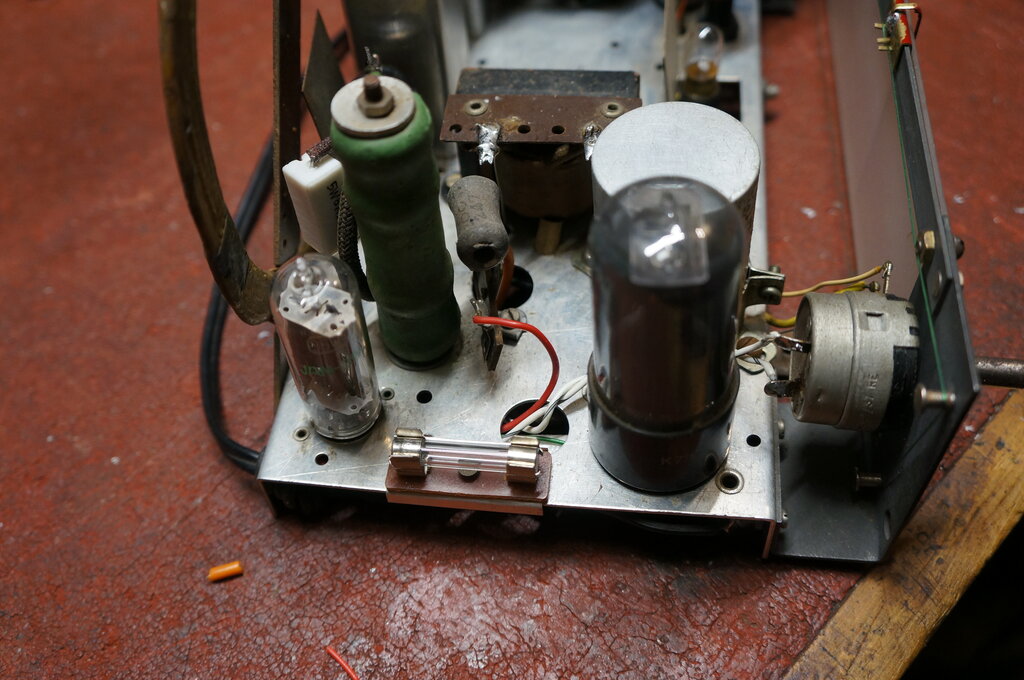
Big green resistor drops the mains voltage for the valve heaters.
Barretters were popular in Australian
and European AC/DC or DC only sets. These resemble a domestic light bulb,
but have an iron filament in a hydrogen atmosphere. Usually, they have
an E27 Edison screw or P base. Unlike a resistor or light bulb, they regulate
the current over a wide mains voltage. So, a typical set could run from
200-250V with no need to adjust anything. Also, the switch on surge is
reduced. It would be possible to use an ordinary light bulb and forego
the regulation feature as a replacement, but more than likely, it will
be necessary to provide a resistor as well, to get the correct heater current.
Barretters are fragile, and must be mounted away from speaker magnets,
since the iron filament will vibrate with the magnetic field and eventually
break.
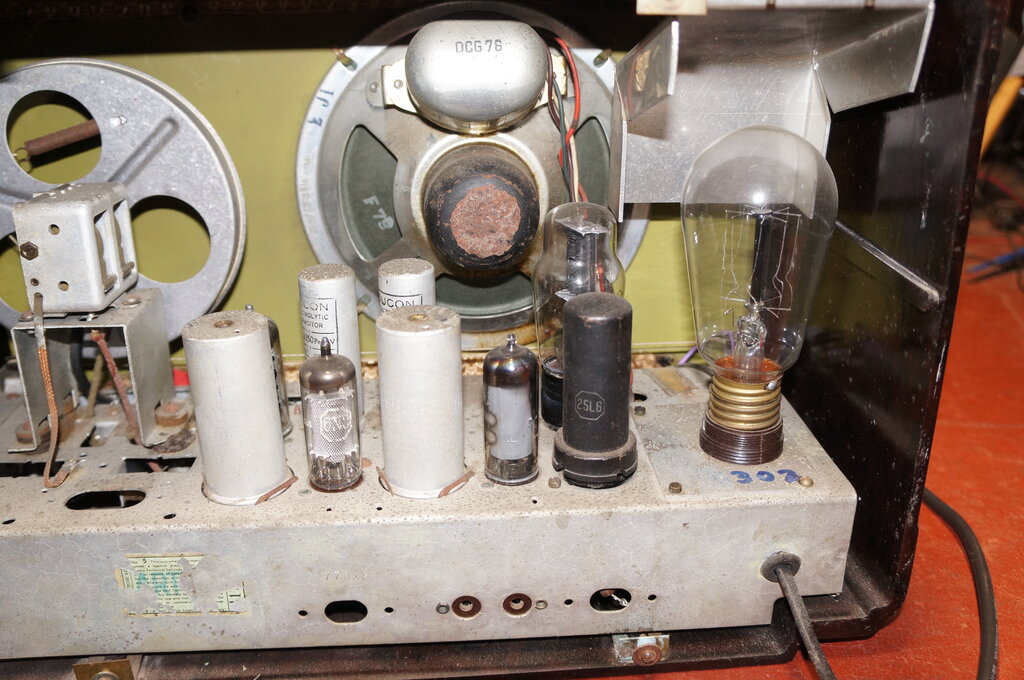
Type 302 barretter is at the right.
Ballast tubes existed in some American
sets from around the 1930's and 40's. One kind is a wirewound resistor
assembled in what looks like a perforated metal valve, and has an ordinary
valve base. It may be possible to fit modern resistors inside the enclosure.
Even if not, they could be put elsewhere inside the set, above the chassis.
The other kind of ballast tube is in a glass envelope, and is really a
barretter under another name.
Light Bulbs can and have been used,
but resistance varies depending on the current flow, so it isn't practical
to calculate what wattage lamp is to be used, and what the associated resistor
(if required) will be. It will have to be done experimentally. As a starting
point, it is easy to determine what the current consumption of a light
bulb at its rated voltage is. P(power of lamp) = I(current) x V(voltage).
For example, a 240V 60W bulb draws about 250mA. A 75W 240V bulb would probably
be a good starting point for use in a set that had a 300mA heater string
(You have hoarded a lifetime supply of incandescent bulbs haven't you?
Because you won't be able to use a CFL or LED bulb in this application!).
Keep in mind that the resistance of a light bulb is much lower cold than
hot, so the switch on surge could be a problem. A thermistor could be of
use here.
Ordinary light bulbs have a tungsten filament,
so have the same temperature coefficient as a string of valve heaters.
Interestingly, a carbon filament bulb performs much like a negative coefficient
thermistor. This data was measured using two 240V 100W bulbs; one with
a tungsten filament, and the other with a carbon filament:
| Volts across bulb |
Carbon filament (mA) |
Tungsten filament (mA) |
| 40 |
45 |
155 |
| 80 |
110 |
230 |
| 115 |
170 |
270 |
| 140 |
235 |
310 |
| 180 |
320 |
360 |
| 215 |
395 |
390 |
| 240 |
415 |
420 |
| Cold resistance |
786 ohms |
40.6 ohms |
Characteristics of 240V 100W carbon and tungsten filament bulbs.
From this, one could deduce that the carbon
filament provides good inrush current protection, with such a high cold
resistance. However it does not provide current regulation like a barretter,
so is unsuitable for operating over a wide voltage range. As mains voltages
have been standardised for some time, this is not as important as it once
was. The tungsten lamp has less of a current variation over a certain voltage
range, but offers no surge protection at all. The effect of using a tungsten
lamp as a valve heater dropper is the same as if all the valve heaters
added up to the mains voltage. For example, if the mains voltage rises
10%, then each of the valve heater voltages rises by 10%.
In comparison, an ordinary wirewound resistor
does offer useful surge protection, but as the resistance does not vary
with current, the valve heaters will be subjected to a greater variation
in voltage than with a tungsten lamp dropper.
For these reasons it can be seen that
the barretter is actually the ideal type of resistive dropper.
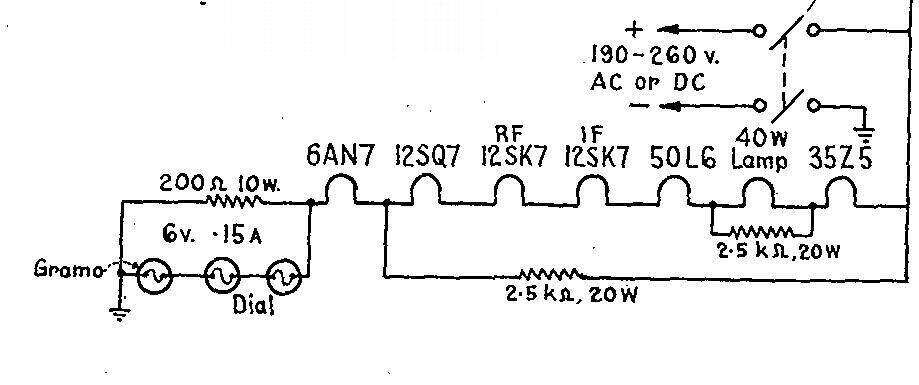
40W light bulb used in the Operatic C64RC.
A domestic 240V 40W light bulb was used
in the Operatic C64RC as the dropper. Service notes indicate that it was
used due to barretters being in short supply. Because the bulb current
is too low on its own, it has a 2.5k resistor shunted across it. The next
size bulb up, 60W, passes too much current. The section of the heater string
comprising the 12SQ7,the 12SK7's, 50L6, and 35Z5 draws 150mA. Since the
6AN7 requires 230mA, the 150mA section is shunted by another 2.5k resistor.
Line cord resistors took over from
ballast tubes and other dropper resistors mounted inside radio cabinets,
and lasted until the 1950's when they fell from use. By then, a series
of valves had been developed for typical radio use which had 150mA heaters,
and when used together added up to around 122V, thus dispensing with the
need for any dropper for the U.S. mains supply. Line cord resistors were
not used with Australian sets due to their safety hazards, and were not
permitted by the authorities.
The reason for their popularity is that
they allowed midget sets to be constructed, as all the heater dropper heat
was dissipated outside the cabinet. Room was also not required inside the
set for the large resistor or ballast tube.
A line cord resistor looks like an ordinary
cloth covered appliance cord, but closer examination reveals three conductors.
There are two ordinary conductors, one for (what is hopefully) the neutral,
the other to feed the rectifier plate with the mains voltage. The third
conductor is actually resistance wire wound around the length of the cord
and provides the heater voltage. Needless to say, shortening this kind
of cord will subject the heaters to excessive voltage. Provided the cord
is left stretched out, it dissipates the heat effectively. If left coiled
up, it could be a fire hazard.
The insulation around the resistance wire
is unreliable making them a shock hazard. Also, the resistance wire is
not as flexible as the ordinary conductors. So, continual rolling up or
moving the cord will eventually cause it to break. It's the usual cause
of no heaters lighting in a set fitted with one.
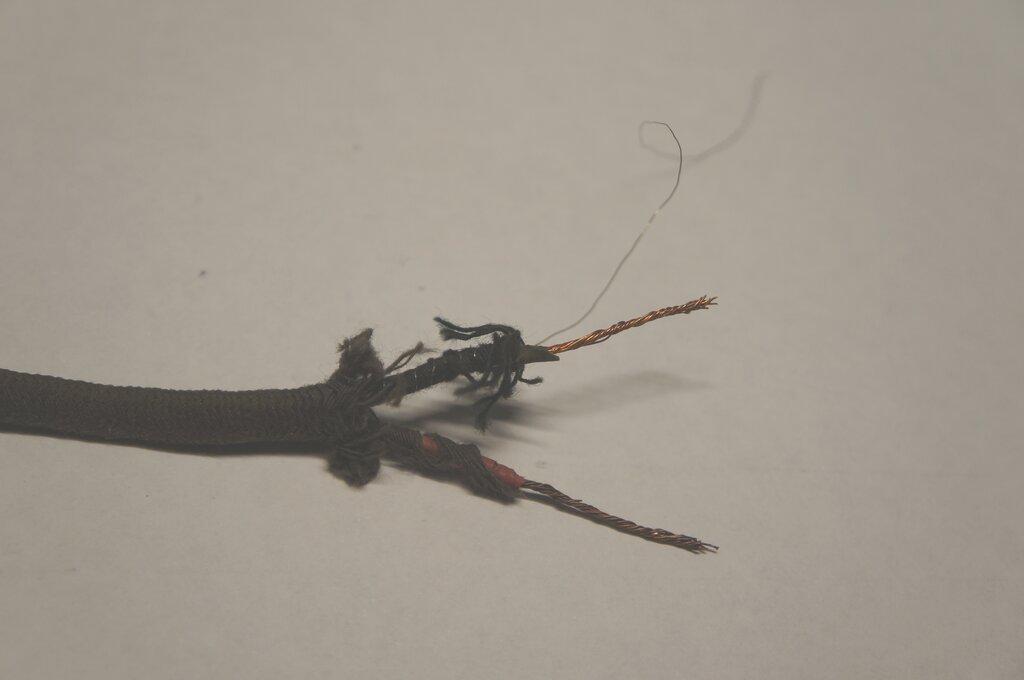
Construction of a line cord resistor. The red and black conductors
connect to the mains plug and thus provide full voltage to the B+ rectifier.
Wound around the black conductor can be seen the nichrome resistance wire
for dropping the voltage for the valve heaters. With nothing but
a woven cotton outer covering, the shock hazard is obvious.
And so to the Line Cord Resistor
Replacement:
Line cord resistors have not been made
for many years, and with today's regulations, probably never will be again.
Faced with an open circuit line cord, many restorers have resorted to other
types of dropper, which apart from detracting from originality, can present
its own challenges. Replacing a line cord with an ordinary resistor is
often not practical because the set's cabinet is too small to accomodate
it, and the resulting heat dissipation will cause damage. Sometimes the
resistor has been installed in an external metal box, which obviously stands
out like the proverbial.
Some restorers use capacitive droppers
which have the advantage of no heat dissipation, and provided there is
enough room in the cabinet are a practical alternative. However, many restorers
make the error of simply calculating the capacitor value by the equivalent
reactance, which overloads the valve heaters. There are limitiations of
this type of dropper which need to be understood before choosing it. The
details of how to design a capacitive dropper circuit are covered in Part
2.
Diode droppers also take up little space,
but for most applications a dropper resistor is still required. Nevertheless,
the size of resistor and its heat dissipation is a lot less than a resistor
on its own. Again, the calculations are often done in error, assuming the
voltage is simply halved, with the valves being overloaded. The details
are covered in Part
3.
A transformer in an external box is another
option, but again looks out of place. Once in a while, there is just enough
room to install a small heater transformer inside the set, as was done
with this Meck FM converter.
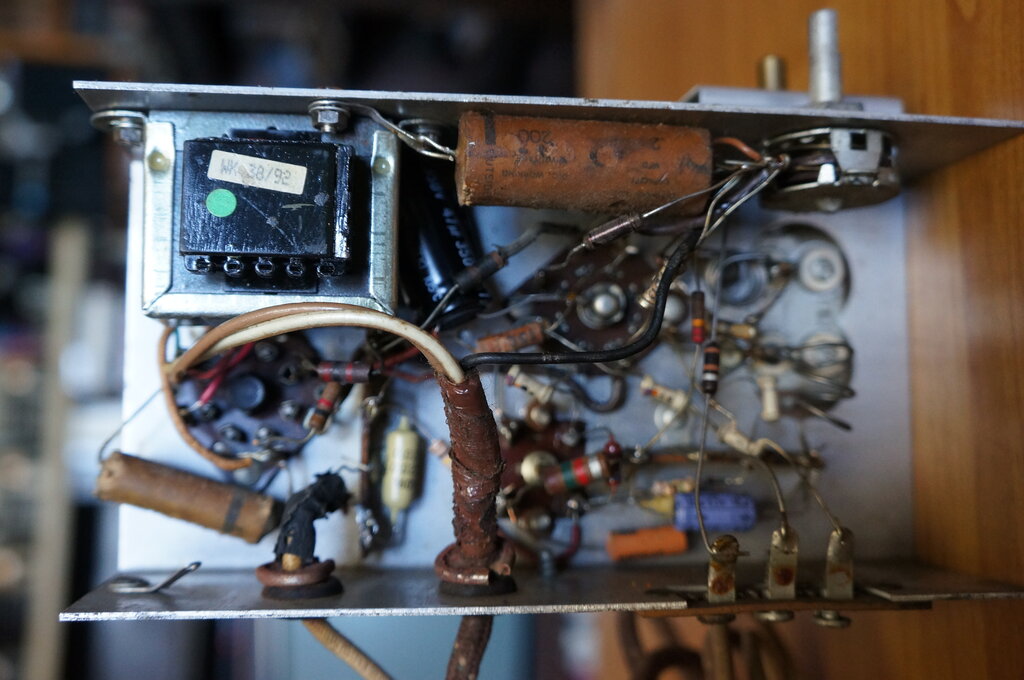
Since only 12.6V at 300mA was required, there was enough room to
fit this heater transformer in a Meck FM converter.
However, it occurred to me that it should
be possible to make a replacement using wire from an electric blanket heating
element. This has the required insulation (in fact, much better than what
was originally used), and flexibility requirements (again, vastly improved
on the original). By shrouding it in hollow shoe lace along with two ordinary
conductors, it should therefore be possible to make an authentic replacement.
Indeed, it turned out that electric blanket element wire also had the right
electrical characteristics, and the idea has been successfully implemented
on two receivers so far.
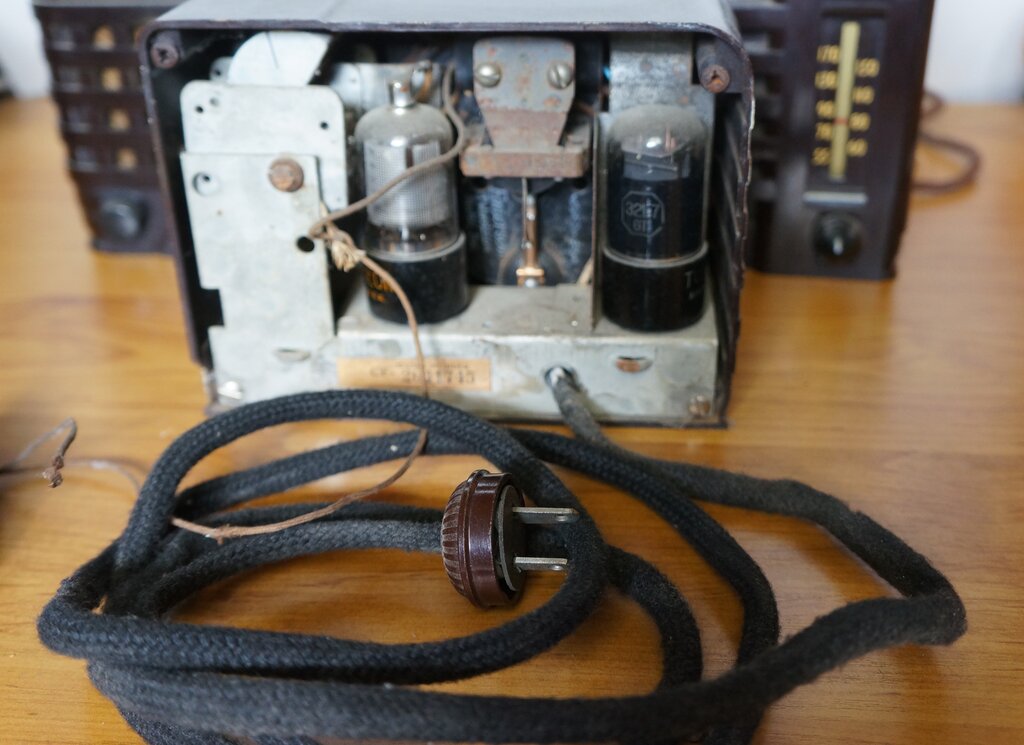
Reproduction line cord resistor made for an Emerson CF255.
Thus, there is no need to butcher the original
radio with non original droppers.
The first reproduction line cord resistor
was used on one of my Meck FM converters. See
the full description here.
The second was made for one of my Emerson
CF255's. This set requires a tap for the dial lamp, but this was easily
provided.
Transformers.
No introduction needed here. Efficiency
is high, and there's no asymmetrical loading of the mains or reducing the
power factor. Not frequency critical within limits either. As we're talking
about live chassis sets here, an auto transformer can also be used. Obviously,
a transformer is the best way to power the heaters when practical. Of course,
transformers are suitable only for AC supplies.
Using droppers for other loads.
For purely resistive loads, like light
bulbs, brush motors or heating elements, any of the droppers described
will work. However, with the exception of using a transformer, all the
droppers will give higher voltage on no load, so are only suitable for
constant loads.
For inductive loads like small shaded
pole induction motors, anything but the diode dropper will work. The capacitive
dropper will work, but the calculations are not the same. Suffice to say,
it's easiest to use trial and error. I had to replace the fan motor in
one of my fan heaters. As it happened I had U.S made motor that fitted
perfectly. However, I had to drop 120V to use it on the local 240V supply.
I used a 2.8uF 440VAC capacitor in series
which worked perfectly. Note that because of resonance effects, the voltage
across the capacitor may be much higher than the mains supply. This is
why motor run capacitors are 440V and not 250VAC.
Home








